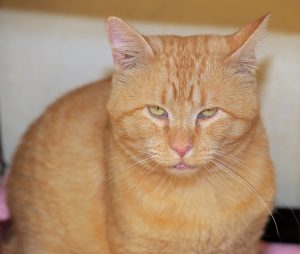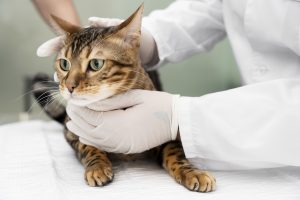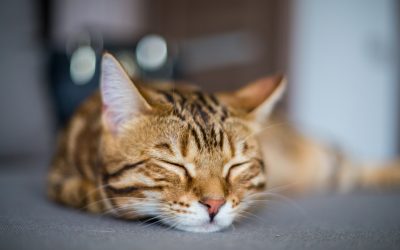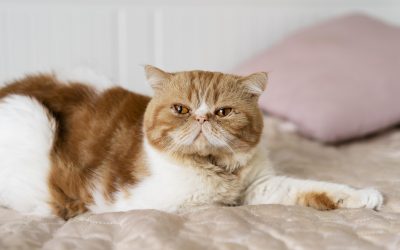Hypertrophic Cardiomyopathy (HCM) in Cats [Guide]
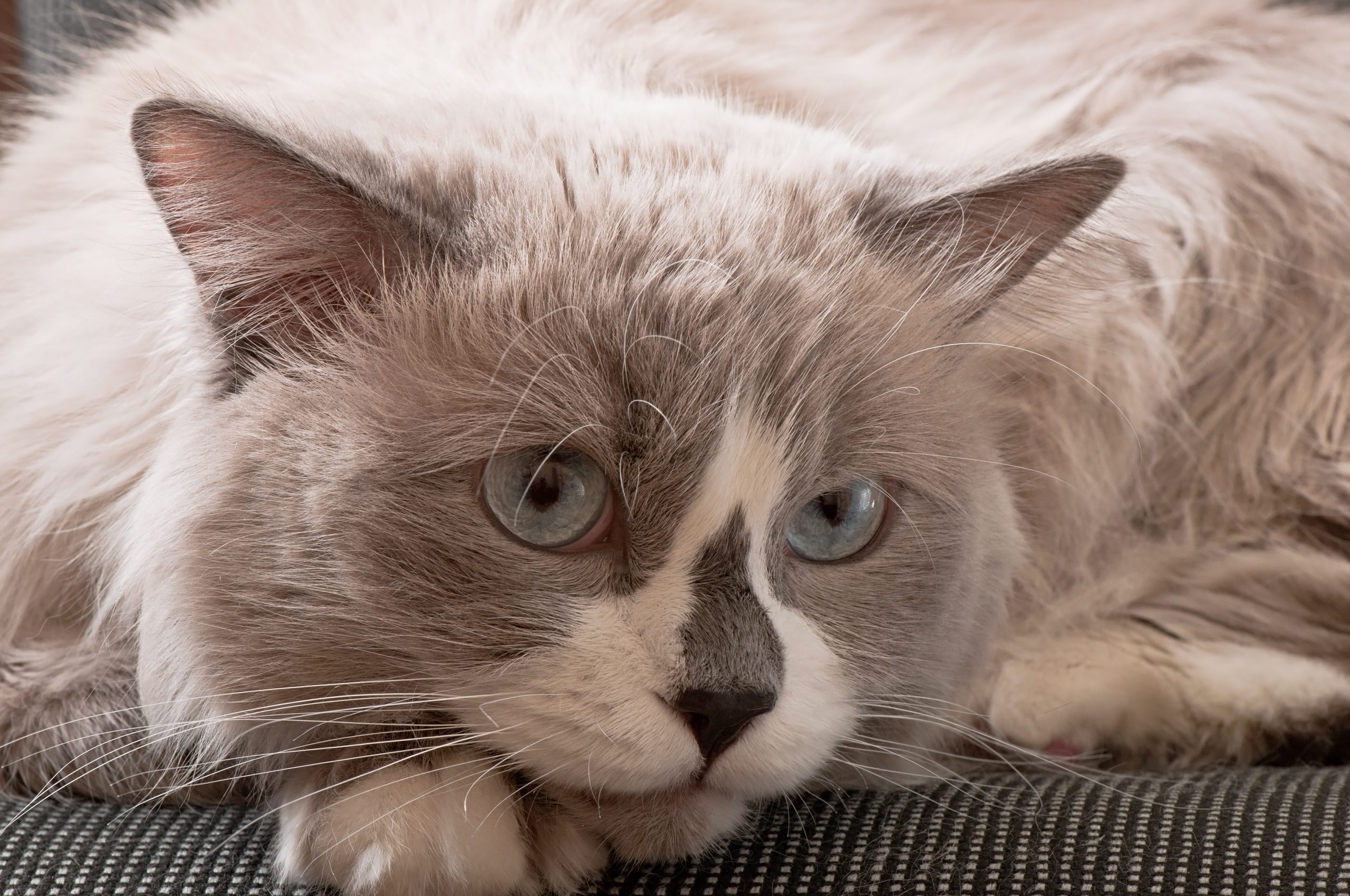
Hypertrophic cardiomyopathy (HCM) is a common heart condition in cats, characterized by the thickening of the heart muscle, particularly the left ventricle. This abnormal thickening can impair the heart’s ability to efficiently pump blood throughout the body, leading to various complications. HCM is a serious condition that requires prompt diagnosis and appropriate management to ensure the well-being of affected felines.
Cats of any age can develop HCM, but it is most prevalent in middle-aged and older cats. Understanding the causes, symptoms, and preventive measures for feline HCM is crucial for cat owners to ensure their beloved companions’ optimal health and longevity.
Causes and Risk Factors of Feline Hypertrophic Cardiomyopathy (HCM)
The primary cause of HCM in cats is genetic. Specific genetic mutations have been identified in certain cat breeds, leading to the development of this condition. Cats with a family history of HCM are at a higher risk of inheriting the disease. Additionally, certain factors can contribute to the progression of HCM, including:
- Breed Predisposition: As mentioned earlier, certain cat breeds, such as Maine Coons, Ragdolls, and British Shorthairs, are more prone to developing HCM due to genetic factors.
- Age: The risk of developing HCM increases with age, with the condition being more common in middle-aged and older cats.
- Gender: Male cats may be slightly more susceptible to HCM than females.
- Underlying Medical Conditions: Conditions such as hyperthyroidism, high blood pressure, and diabetes can increase the risk of developing HCM or exacerbate the condition.
- Obesity: Excess weight can strain the heart and contribute to the development or progression of HCM.
Understanding these risk factors can help cat owners and veterinarians identify cats at a higher risk of developing HCM and take proactive measures to monitor and manage the condition.
Signs and Symptoms of Feline Hypertrophic Cardiomyopathy (HCM)
The signs and symptoms of HCM in cats can vary greatly, depending on the severity of the condition and the individual cat’s response to the disease. Some common signs and symptoms of feline HCM include:
- Lethargy and Decreased Activity: Cats with HCM may exhibit reduced energy levels, decreased activity, and a general lack of enthusiasm for their usual activities.
- Difficulty Breathing: As the heart’s ability to pump blood efficiently decreases, cats may experience difficulty breathing, particularly during increased activity or stress periods.
- Coughing or Wheezing: Fluid buildup in the lungs is a common complication of HCM, which can lead to coughing or wheezing in affected cats.
- Fainting or Collapse: Severe cases of HCM can cause sudden fainting or collapsing episodes, often triggered by stress or physical activity.
- Abdominal Distension: Fluid accumulation in the abdomen, known as ascites, can cause the abdomen to appear swollen or distended.
- Loss of Appetite and Weight Loss: Cats may experience a decreased appetite and unintentional weight loss as the condition progresses.
- Heart Murmurs: Veterinarians may detect heart murmurs during routine physical examinations, which can be an early indicator of HCM.
It’s important to note that some cats with HCM may not exhibit any obvious symptoms, especially in the early stages of the disease. Regular veterinary check-ups and monitoring are essential for the early detection and management of this condition.
Diagnosis of Feline Hypertrophic Cardiomyopathy (HCM)
Diagnosing HCM in cats typically involves a combination of physical examinations, diagnostic tests, and imaging procedures. The diagnostic process may include the following steps:
- Physical Examination: The veterinarian will conduct a thorough physical examination, listening to the cat’s heart and lungs for any abnormalities.
- Echocardiogram: This non-invasive ultrasound examination of the heart provides detailed information about its structure and function, allowing the veterinarian to assess the presence and severity of HCM.
- Electrocardiogram (ECG): An ECG records the heart’s electrical activity, which can help identify any abnormalities associated with HCM.
- Blood Tests: Blood tests may be performed to rule out underlying conditions that could contribute to or exacerbate HCM, such as hyperthyroidism or kidney disease.
- Chest X-rays: Chest X-rays can help detect the presence of fluid buildup in the lungs or abdomen, which can be a consequence of HCM.
- Genetic Testing: In some cases, genetic testing may be used to identify specific genetic mutations associated with HCM, particularly in breeds known to be predisposed to the condition.
The combination of these diagnostic tools allows veterinarians to accurately diagnose HCM, determine the severity of the condition, and develop an appropriate treatment and management plan for the affected cat.
Treatment and Management of Feline Hypertrophic Cardiomyopathy (HCM)
The treatment and management of feline HCM depend on the severity of the condition and the individual cat’s response to various therapies. The primary goals of treatment are to alleviate symptoms, prevent complications, and improve the cat’s quality of life. Treatment options may include:
- Medication: Cats with HCM may be prescribed medications such as beta-blockers, calcium channel blockers, or diuretics to help manage symptoms, reduce the workload on the heart, and prevent the development of complications.
- Dietary Modifications: Adjustments to the cat’s diet, such as reducing sodium intake and providing a balanced, low-calorie diet, may help support heart health and prevent weight gain.
- Fluid Management: In cases of fluid buildup in the lungs or abdomen, veterinarians may recommend diuretic medications or other interventions to help remove the excess fluid and improve the cat’s breathing and overall comfort.
- Monitoring and Regular Check-ups: Cats with HCM require regular veterinary check-ups and monitoring to assess the progression of the disease and adjust the treatment plan as needed.
- Lifestyle Adjustments: Limiting strenuous physical activity and providing a stress-free environment can help minimize the strain on the cat’s heart and improve their overall well-being.
It’s important to note that managing HCM in cats is an ongoing process. The veterinary team will work closely with the cat owner to develop and adjust the treatment plan as the condition progresses.
Surgical Interventions
In some cases, surgical interventions may be considered for the management of feline HCM, particularly in cases where medical therapy is not effective or the condition has progressed significantly. Potential surgical options include:
- Septal Myectomy: This procedure involves surgically removing a portion of the thickened heart muscle (septum) to improve blood flow and reduce the obstruction caused by the hypertrophied tissue.
- Pacemaker Implantation: In some cases, a pacemaker may be implanted to help regulate the heart’s electrical activity and improve the efficiency of the heart’s pumping function.
- Heart Transplantation: In rare and severe cases, heart transplantation may be considered, but this procedure is not widely available for cats and carries significant risks.
Surgical interventions for feline HCM are not commonly performed and are typically reserved for cases where medical management is ineffective or the condition has progressed to a critical stage. The decision to pursue surgical treatment will be made in close consultation with the veterinary team and the cat’s owner, considering the individual cat’s risks, benefits, and overall prognosis.
Living with a Cat Diagnosed with HCM
Caring for a cat with HCM can be a challenging but rewarding experience. Here are some key considerations for cat owners with a feline HCM diagnosis:
- Medication Compliance: Ensuring that the cat receives their prescribed medications as directed is crucial for managing the symptoms and slowing the progression of the disease.
- Monitoring and Reporting Changes: Closely monitoring the cat’s behavior, appetite, and overall well-being and promptly reporting any changes to the veterinarian can help adjust the treatment plan as needed.
- Environmental Management: Providing a stress-free, low-activity environment can help minimize the strain on the cat’s heart and improve their quality of life.
- Dietary Adjustments: Working with the veterinarian to develop a specialized, heart-healthy diet can support the cat’s overall health and potentially slow the progression of HCM.
- Regular Veterinary Check-ups: Adhering to the recommended schedule of veterinary check-ups and diagnostic tests is essential for monitoring the cat’s condition and making timely adjustments to the treatment plan.
- Emotional Support: Caring for a cat with a chronic, progressive condition can be emotionally challenging for the owner. Seeking support from the veterinary team, support groups, or mental health professionals can help manage the stress and anxiety associated with the diagnosis.
By working closely with the veterinary team and implementing the recommended management strategies, cat owners can help improve the quality of life and longevity of their feline companions diagnosed with HCM.
Preventive Measures and Breeding Considerations
While the primary cause of HCM in cats is genetic, there are some preventive measures that can be taken to minimize the risk of the condition:
- Genetic Testing: Genetic testing of breeding stock can help identify carriers of the disease-causing mutations in cat breeds known to be predisposed to HCM, allowing breeders to make informed decisions about breeding programs.
- Responsible Breeding Practices: Breeders should prioritize the health and well-being of the cats and avoid breeding cats with a known history of HCM or other genetic disorders.
- Regular Veterinary Check-ups: Routine veterinary check-ups, including echocardiograms, can help detect HCM in cats at an early stage, allowing for prompt management and potentially slowing the progression of the disease.
- Maintaining a Healthy Weight: Keeping cats at a healthy weight through a balanced diet and regular exercise can help reduce the strain on the heart and potentially slow the development or progression of HCM.
- Addressing Underlying Medical Conditions: Promptly treating any underlying medical conditions, such as hyperthyroidism or high blood pressure, can help prevent or manage HCM in cats.
Can Odie Pet Insurance Provide Coverage for Such an Investment?
Depending on the specific policy, pet insurance can cover the diagnosis, treatment, and management of hypertrophic cardiomyopathy in cats.
Reimbursement
This method is the most common for pet insurance companies. You pay out of pocket for the veterinarian bill, and then the insurance company reimburses you for what’s covered under the insurance plan. The steps look like this.
- You pay the vet bill after your cat’s visit.
- You fill out the pet insurance claim form.
- Submit the claim form and other required documentation to the insurer.
- After the claim is approved, you will be reimbursed for eligible expenses.
What Does Odie Pet Insurance Cover?
Pet insurance covers various veterinary expenses, providing financial protection and peace of mind for pet owners. Here are the details of the coverage options offered by Odie Pet Insurance:
Illness & Injury Plan
The Illness & Injury Plan is an all-inclusive insurance plan designed to cover a wide range of medical needs for your pet. This plan includes comprehensive coverage for various illnesses, injuries, and veterinary services. Some of the covered items include:
- Veterinary exams and consultations
- Diagnostics (e.g., X-rays, lab tests)
- Prescribed medications
- Surgeries and hospitalization
- Rehabilitation, acupuncture, or chiropractic treatments
- Medically necessary supplies
- Euthanasia and cremation
The Wellness Plan
The Wellness Plan is a monthly membership that focuses on preventive care and covers routine veterinary services.
- Provides reimbursements for routine care items such as wellness visits (exams and vaccines), testing and parasite prevention, dental cleanings and at-home dental care, vitamins, supplements, and more.
- Through Odie’s partnership with Petivity, a leader in smart pet products and proactive care, Wellness Plan members can also receive reimbursements for Petivity devices and health kits, as well as eligible Purina food and supplements.
- Total reimbursement up to $700 per year.

